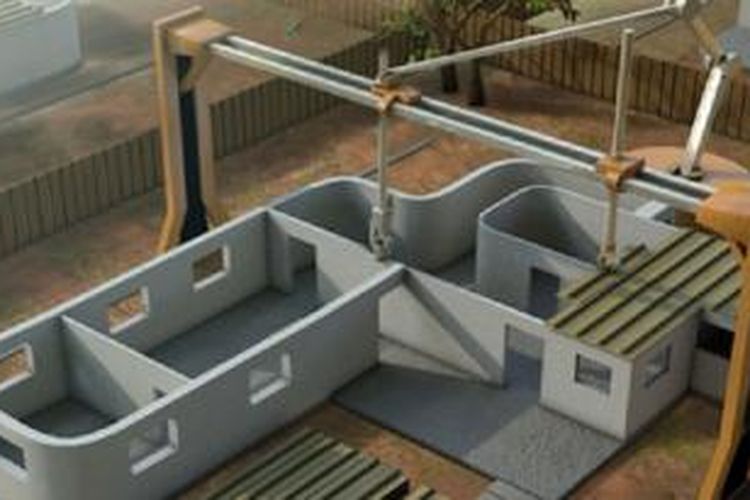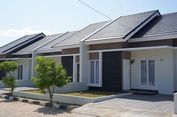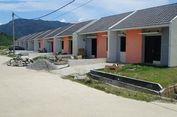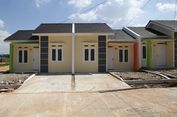Hanya 24 Jam, Bangun Rumah dengan Teknologi Konstruksi Ini

Adalah sekumpulan peneliti University of Southern California, berhasil mengembangkan teknologi printer tiga dimensi (3D) raksasa untuk kepentingan membangun hunian dua lantai hanya dalam waktu 24 jam.
Teknologi fabrikasi (pencetakan) lapisan per lapisan (layer) yang disebut sebagai Contour Crafting, diciptakan oleh Behrokh Khoshnevis. Teknologi tersebut menggunakan derek yang dikendalikan komputer untuk membangun rumah dengan cepat dan efisien serta secara substansial mereduksi proses pembangunan manual.
Pada awalnya, teknologi ini dipahami sebagai metode untuk membangun cetakan di sektor industri manufaktur. Namun, Khoshnevis memutuskan mengadaptasi teknologi ini untuk industri perumahan sebagai cara yang cepat, tepat, dan efisien guna membangun kembali hunian setelah hancur diterjang bencana alam, seperti gempa bumi dahsyat yang telah melanda negerinya, Iran, beberapa tahun lalu.
Teknologi ini m
enggunakan pengaturan serba cepat dengan perhitungan presisi, material seperti beton dibentuk menjadi dinding lapis demi lapis hingga kemudian diakhiri pembentukan lantai dan langit-langit yang ditempatkan sesuai modul dengan menggunakan derek (crane). Konsep konstruksi ini memungkinkan penyisipan komponen struktural, pipa, kabel, utilitas, dan bahkan perangkat konsumen seperti sistem audiovisual ke dalam lapisan tersebut.Teknologi robot, memang bukan hal baru, karena selama beberapa dekade telah mampu merevolusi industri mobil, dan digunakan sebagai piranti rumah tangga dalam membersihkan debu atau bahkan untuk menjelajalah planet Mars. Namun, teknologi robot untuk keperluan industri perumahan, belum banyak dikembangkan."Sebuah rumah tunggal atau kompleks perumahan, masing-masing dengan kemungkinan desain yang berbeda, dapat secara otomatis dibangun dengan hanya menanam satu tiang pancang untuk keperluan pembuatan saluran untuk listrik, pipa dan AC," ujar pengembang situs Contour Crafting.
Aplikasi mesin 3D ini tak hanya memudahkan pekerjaan konstruksi, melainkan juga hemat ongkos konstruksi. Terlebih untuk pembangunan rumah-rumah darurat korban bencana.
Hanya, produk 3D ini masih harus diselidiki lebih lanjut. Oleh karena itu, University of Southern California kemudian membentuk sebuah tim peneliti multidisiplin yang relatif besar. Penyelidikan ini dilakukan terhadap kemungkinan penerapan teknologi dalam pembangunan struktur sipil modern, pembangunan struktur di bulan dan Mars, dan seni rupa pada penciptaan patung keramik besar.
At least that is what researchers at the University of Southern California believe. They have developed a giant 3D printer to build a two-story home in just 24 hours.
The layer-by-layer fabrication technology, known as Contour Crafting, was created by professor Behrokh Khoshnevis. The robotic process replaces construction workers with a "house printer" fitted with fast-drying concrete to create a home based on a computer pattern.
Robot technology has revolutionized the car industry, and are used in every day duties such as vacuuming a house to exploring the planet Mars. Now, professor Khoshnevis wants to improve the housing industry.
"A single house or a colony of houses, each with possibly a different design, may be automatically constructed in a single run, embedded in each house all the conduits for electrical, plumbing and air-conditioning," the developers say.
This week the National Association of Home Builders announced a drop in builder confidence, with some citing rising construction costs. A new report from the U.S. Census Bureau showed a drop in housing starts in December.
Current applications of 3D machines are used to create all kinds of items using plastics and polymers, among other materials, becoming a hot topic for technology conferences around the country. Consumers can even purchase printers to create 3D products at home.
Potential real-world applications for the large 3D printing technology include emergency, low-income and commercial housing, according to the developers' website.
Future plans for Contour Crafting go beyond planet earth.
"A relatively large multidisciplinary research team at the University of Southern California will be investigating the application of the technology in construction of modern civil structures, construction of structures on the moon and Mars, and in fine arts on the creation of large ceramic sculptures," according to the website.
- See more at: http://www.worldpropertychannel.com/north-america-residential-news/3d-printing-of-homes-future-of-home-construction-methods-contour-crafting-housing-starts-builder-confidence-new-home-building-technology-7899.php#sthash.s99qgnBs.dpuf


















![[POPULER PROPERTI] Terkuak Alasan Rumah Tusuk Sate Tak Diminati](https://asset.kompas.com/crops/n2pmNfmzrNRAJb0rvUvuAJlBwpE=/0x155:1920x1435/177x117/data/photo/2025/06/27/685e4e4066a0e.jpg)























